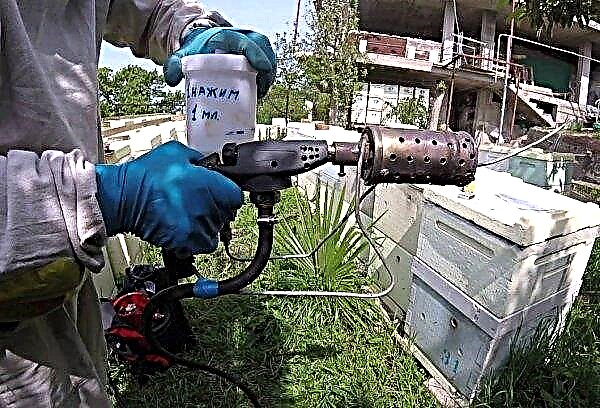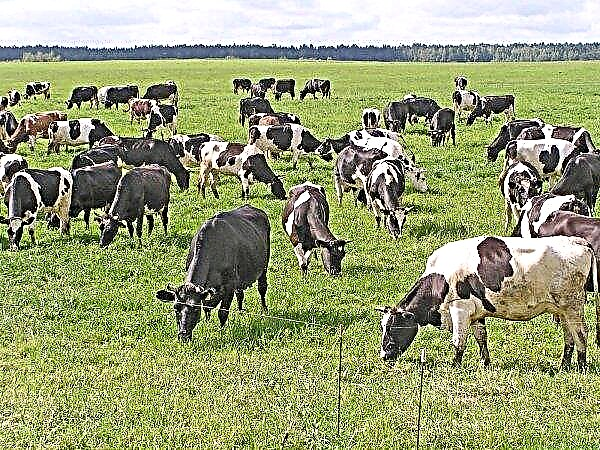Owners of private houses often start chickens in their yard to have fresh chicken eggs on hand. For these poultry, certain conditions must be created so that their productivity is at their best. Find out what you need to build a chicken coop, how to do it and what to consider.
Preparation for the construction of the chicken coop in the country
Before building a chicken coop, you should carefully consider the project based on available space, budget, and the desired number of birds.
Seat selection
It is important to immediately choose the right place for this business building, because then it can no longer be moved. It is best to build on a hill, slope or any place where water is dry and does not stagnate in spring, puddles do not form. Excessive dampness negatively affects the health of domestic chickens and on the building itself.
It is recommended that the windows go south so that the natural light is longer. Other openings are best made west or east to avoid northerly winds.
The chicken coop should be located away from highways and other noisy places so that birds are not disturbed by outside noise. You need to think about where there will be an aviary adjacent to the hens for the hens.
Tools and materials
The easiest way to make a chicken coop from boards and bars with the floor content of chickens, for which you will need to purchase a set of the following materials:
- boards, timber;
- nails and screws;
- Rabitz;
- insulation (mineral wool, sawdust or foam boards);
- cement;
- sand;
- roofing material;
- slate or other roofing material;
- door hinges, lock;
- bricks;
- electric cable and lamp.
To build a chicken house yourself, you need the following tools:
- saw;
- hammer;
- level;
- shovel;
- ruler or meter.
Did you know? The smallest breed of chickens is considered seram, whose representatives in adulthood weigh only 300-600 g. The largest include chicken brama and master gray - up to 7000 g.
Chicken coops of different sizes. Blueprints
A drawing of the future chicken coop for laying hens should be done even before the purchase of building materials, well thought out all the nuances. Any chicken coop is built at the rate of 1 sq. Km. m accounts for no more than 5 adults.
Any chicken coop is built at the rate of 1 sq. Km. m accounts for no more than 5 adults.
Important! Failure to observe bird densities reduces the productivity of laying hens and can lead to biting of chickens.
Recommended Standards for Density:
- per 1 sq. m chicken coop with deep litter - from 2 to 5 layers;
- on a mesh or slatted floor, 10-12 chickens can be placed;
- for growing broiler chickens with an outdoor content, these standards increase to 10-15 individuals, although some poultry farmers do not recommend keeping per 1 sq. m. m more than 6 broilers 55 days old.
In household conditions, earthen floors with deep litter of sawdust and straw are usually made, since they require a minimum of investment, so it is worthwhile to stay at a rate of up to 5 layers. In this case, one should not forget about the aviary for walking, which takes up even more area. It is made at the rate of 1-2 square meters. m per 1 adult. For the building to be used in winter, a vestibule should be made in front of the entrance to the chicken coop itself in order to keep heat in the birdhouse itself. It is also convenient to store food, tools and other items necessary for caring for chickens in it.
For the building to be used in winter, a vestibule should be made in front of the entrance to the chicken coop itself in order to keep heat in the birdhouse itself. It is also convenient to store food, tools and other items necessary for caring for chickens in it.
If there is not enough space, you can replace it with a canopy, which usually consists of a dense fabric or film and hangs for the winter.
When drawing up the drawing, determine where there will be perches and nests, feeders and drinking bowls, a bird hole for walking, a door for a person, window openings (10% of the floor area).
Mini chicken coop for 5-10 chickens
For their own consumption of eggs, a small family will have 5-10 chickens. The chicken coop for such a number of birds will take no more than 4 square meters. m
A walking enclosure adjacent to the chicken coop 2 × 2 m, will occupy 12 square meters. m (2 × 6 m). The tambour will be 1.5 × 2 m in size.
Shed for 20-30 chickens
The area of the main room for a chicken coop for 20-30 chickens should be about 8-10 square meters. m
Walking area will take at least 20 square meters. m
Coop for 50–100 chickens
Planting density with such a number of birds can be brought up to 5 individuals per 1 square. m
For keeping up to 100 birds, a building of 20 square meters will be necessary. m
Large chicken coop for 200-500 goals
Experienced farmers recommend dividing a large herd of chickens into 2 parts - this makes it easier to care for them and prevents the spread of infections. So you can build two sections of 50 square meters. m, or one chicken coop per 100 square meters. m. If it is not expected to increase the number of livestock, then for 200 chickens one area of 40-50 square meters will be enough. m
For 1000 chickens, 4 sections of at least 50 square meters should be prepared. If the livestock does not grow by more than 300 individuals, then for chickens one construction from 60 square meters will be enough. m
Features of the construction of a winter chicken house
During the construction of the winter chicken coop, the absence of drafts and fairly warm weather, even on frosty days, are an important point. The standard temperature regime should not be lower than + 10 ° С, and when keeping hens - within + 15 ° С ... + 25 ° С. At temperatures below + 15 ° C, egg production drops significantly.
If the temperature drops below 0 ° C, then it is necessary to install heating devices for heating the chicken coop. It can be stoves, radiators, convectors.
The room must be insulated without fail, the slots are closed, a thick layer of sawdust and straw should lie on the floor, the presence of a vestibule is recommended. It is necessary to take care of additional lighting for the winter. Daylight hours should be about 12 hours a day.
Coop in a polycarbonate greenhouse
You can quickly build a winter coop from a polycarbonate greenhouse, but it is important to properly insulate it.
The first step is to insulate the foundation. If it is pile or columnar type, it is lined with wooden boards. To make the insulation stronger, you need to fix two layers of boards, slightly deepening them in the ground, and place heat-insulating material between them (for example, foam).
With a strip foundation, it is dug from both sides around the perimeter, laid with a foam wrapped in a film, and then covered with roofing material and covered with earth. In the inner part, you can stick the film, leaving a margin of about 3 cm, and fill it with soil from the inside and outside - this will protect well from the cold.
When severe frosts occur, you should take care of heating. In this case, electric radiators or convectors are usually chosen. In harsh winters, you can install water heating or soil heating:
In harsh winters, you can install water heating or soil heating:
- The floor should be leveled and a layer of sand poured (approximately 1 cm).
- On top of the sand, make a flooring from a protective grid and lay on it a cable for electric heating, to which you need to connect a thermostat and relay. The thermostat will automatically control the room temperature.
- A protective net and sand of 1 cm are again overlaid on top.
- Then this building is covered with earth and carefully rammed.
Of course, you will have to pay for electricity, but the productivity of chickens will not decrease due to the cold.
You can place compact wooden houses for a comfortable stay of chickens and their warming. It is also advisable to arrange walking.
Inside, such a greenhouse is equipped like a regular chicken coop:
- the floor is covered with litter (sawdust, straw);
- equip nests in a quiet place;
- arrange shelves and feeders;
- conduct lighting.
The insulated and equipped chicken coop made of polycarbonate will last long enough due to its strength.
How to make a chicken coop
The following describes the basic steps necessary to build a chicken coop at home.
Step number 1 - the choice and construction of the foundation
For a summer residence, as a rule, they put light constructions of a wooden beam or logs as a house, therefore, as a foundation, blocks under the foundation are quite suitable, which can be purchased, or can be made on their own. Usually they are made in the form of columns. In the corners of the planned house, load-bearing columns are placed, which can be made of wood, bricks or other materials. They are buried in the ground by about 30 cm. Then, supports with dimensions of 40 × 20 × 20 cm are placed. Blocks should be waterproofed with bitumen in places of contact with the ground. Large gravel is poured between the supports and the ground.
In the corners of the planned house, load-bearing columns are placed, which can be made of wood, bricks or other materials. They are buried in the ground by about 30 cm. Then, supports with dimensions of 40 × 20 × 20 cm are placed. Blocks should be waterproofed with bitumen in places of contact with the ground. Large gravel is poured between the supports and the ground.
Did you know? Hens are considered outgoing individuals. Even the chicken in the egg a few days before birth is talking to the chicken mother with a dozen signals. He reacts to her presence and absence, clattering, to an alarm.
For very small and light houses, the foundation is not needed at all. It is enough to deepen metal plates along the walls to protect against predators.
Step number 2 - the construction of the frame of the chicken coop
In cottages and small private courtyards, the construction of the chicken coop is done using frame technology. For such a structure, a small-diameter beam is used, and boards, plywood and other building materials are taken as the sheathing. The walls are insulated and stuffed on top of a fine-grained metal mesh to protect against rodents and predators. The choice of the thickness of the timber and insulation depends on the external climate. In the middle lane use a thick beam, which is well caulked by tow.
The walls are insulated and stuffed on top of a fine-grained metal mesh to protect against rodents and predators. The choice of the thickness of the timber and insulation depends on the external climate. In the middle lane use a thick beam, which is well caulked by tow.
The lower harness is carried out using wooden bars, which are fastened with screws to the support. Be sure to leave openings for windows - they are needed for ventilation and lighting. Then the boards must be upholstered with boards on both sides, and between them put a layer of insulation; mineral wool or sawdust is suitable for this.
Height is enough 1.8 m from floor to ceiling.
Important! For the construction and maintenance of the chicken coop, it is recommended to use wood and sawdust from conifers, as they have disinfecting properties and repel insects.
Step number 3 - roof and ceiling
For a small chicken coop in a country house or a private compound, a gable roof is enough. This embodiment will prevent the accumulation of precipitation in the form of snow or rain, and therefore, prevent the appearance of unwanted moisture. For the construction of the roof, the flooring is initially made, and then the beams for the ceiling are installed at an angle of up to 40 °. The flooring is covered with insulating material. As such material, improvised materials such as coal slag or expanded clay are suitable, it is good to use mineral wool. Then the roofing material is attached to the beam, covering it with slate on top.
For the construction of the roof, the flooring is initially made, and then the beams for the ceiling are installed at an angle of up to 40 °. The flooring is covered with insulating material. As such material, improvised materials such as coal slag or expanded clay are suitable, it is good to use mineral wool. Then the roofing material is attached to the beam, covering it with slate on top.
If the chicken coop is very small, you can make a simple pent roof. To do this, set the bars at an angle of 0.5 m. The roof is covered with roofing material and slate on top of it.
Of course, in terms of operation, a gable roof is convenient - on it you can equip an attic for storing various tools and equipment.
When installing the roof should take care of ventilation. To ensure the ventilation of the room, it is necessary to mount two wooden ducts for ventilation. They are attached at different ends of the room. One box is installed at the ceiling, and the second is 40 cm lower. Flaps are placed on the ventilation pipes.
Important! The duration of daylight hours for laying hens should be at least 10 hours, otherwise this will adversely affect their productivity. It is optimal when the chicken coop is lit for 12-14 hours, therefore, in winter, artificial lighting is used for chickens.
Step number 4 - the floor is laid and insulated
If chickens are going to be raised year-round, then it is necessary to insulate the floor to protect the birds in the event of frost. The floor can be made of boards, concrete mix, and you can also just leave the earthen surface. But for better protection from the cold in the winter, it is better to build a double floor. In this case, after the foundation, one layer of the floor is installed, then beams are mounted on it and covered with insulation.
The floor can be made of boards, concrete mix, and you can also just leave the earthen surface. But for better protection from the cold in the winter, it is better to build a double floor. In this case, after the foundation, one layer of the floor is installed, then beams are mounted on it and covered with insulation.
After the second layer of the floor is laid on top. It should be from smooth smooth boards, without cracks and other damage.
From above, the litter of sawdust, sand, straw is necessarily covered with flooring.
Step # 5 - a chicken hole is made
A manhole for chickens is installed to provide them with access to the enclosure for a walk. At the same time, they try to place the house so that the hole does not look north. The manhole itself is made with a double door at a distance of 15–20 cm from the floor level. The parameters for the chicken coop manhole are 0.3 m wide and 0.4 m high. One manhole is enough for 125 individuals.
Step number 6 - the internal arrangement of the chicken coop
The room for chickens must be equipped with everything necessary for their comfortable life. Perches and nests for laying hens are arranged in a calm and quiet place so as not to disturb the bird when hatched chicks. The number of perches is determined from the calculation: for 1 individual - about 0.3 m perch. For the manufacture of hearts it is better to take a beam with parameters 4 × 6 cm, which must be rounded.
The number of perches is determined from the calculation: for 1 individual - about 0.3 m perch. For the manufacture of hearts it is better to take a beam with parameters 4 × 6 cm, which must be rounded.
Perches should be installed at a height of 0.7-0.8 meters from floor level.
Important! Perches cannot be placed one above the other. The distance between them should be about 35 cm.
For the convenience of maintenance and cleaning, trays are placed under the stubs.
The number of nests is determined from the calculation - 3-5 hens per 1 nest. They are placed 30-40 cm from the floor surface. To build nests, wooden boxes are often used, the bottom of which is covered with sawdust.
Feeding troughs are installed at the rate of 10-12 cm per 1 adult, so that there are no fights due to feed. It is also necessary to install feeders in the form of boxes with sizes of 10 × 10 × 40 cm for chalk and shell rock, necessary for normal egg laying, at a height of 15 cm from the floor.
Step number 7 - exterior decoration
Outside, the walls of the chicken coop are treated with wood paint. Paint should be chosen with the indication "for outdoor use", as it is more resistant to environmental influences. On the outside of the chicken coop, it is necessary to build an aviary with an area of at least 1.5–2 times the size of the house, but it is even better to make it at the rate of 1-2 sq. m per 1 adult. It is advisable that grass grow on the paddock, which chickens like to pinch.
On the outside of the chicken coop, it is necessary to build an aviary with an area of at least 1.5–2 times the size of the house, but it is even better to make it at the rate of 1-2 sq. m per 1 adult. It is advisable that grass grow on the paddock, which chickens like to pinch.
Did you know? In Indonesia, there is a rare black breed of chickens - ayam chemani. They have black color not only feather cover, but also all the insides. Even their blood has a dark shade.
To install the aviary, the bars are dug into the ground, along which the chain-link is pulled. It is necessary to provide a gate.
Thus, the chicken coop can be made with your own hands. However, you should choose the right site for it, calculate the required amount of area based on the desired number of chickens, and correctly carry out the necessary work.












